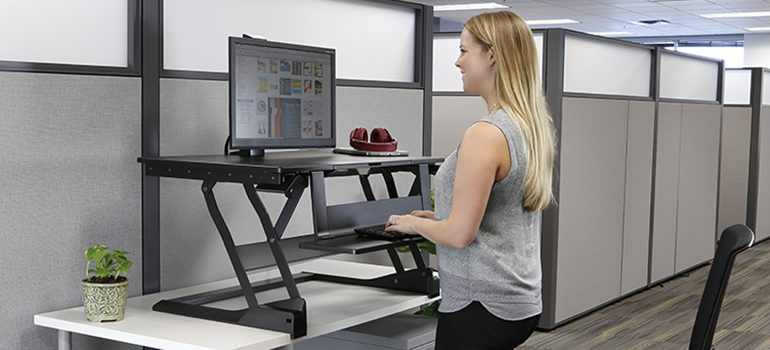This is the first of a three-part series on the principles for achieving well-being and productivity while working at a sit stand workstation.
Looking to improve your posture in the office? You’re on the right track. Good posture is one of the key elements for achieving well-being and productivity while using a computer. To make sure you’re maintaining the best posture, especially as screen time continues to increase, follow these helpful tips:
Engage in natural postures
Ergonomists say that the best posture is the next posture because they realize that sticking to one position is problematic. Whether sitting or standing, your goal is to maintain a “neutral” posture that fosters performance by improving balance, coordination, range of motion, reflexes and recovery time.
It’s important to know what good posture feels like, but it’s just as important to understand what good posture is not. Good posture is not standing at attention with your shoulders flung back and your chin jutting out. It is also not about bunching the shoulders up around the neck or thrusting your chest out. Natural posture never means locking your pelvis, hip or knee joints, and you shouldn’t have your feet placed together or your hands stiff at your sides.
Review screen and keyboard position
Your computer screen position while standing at a sit-stand desk is a critical factor. The top of your computer screen should be about one inch lower than your eyes with the screen situated about an arm’s length away from your face. Your keyboard should be at the height of your elbows, and make sure you type and use your mouse with your elbows tucked close to your waist. Keep your hands at the same level as your forearms, and avoid bending your wrists up or down or to the side.
Assess your chair
In many cases, poor posture in adults can be traced back to bad chair design as early as grade school. Ensure that your chair has five legs with casters to move easily across the floor. Familiarize yourself with your chair adjustments, and make use of the built-in controls, including seat pan tilt, seat height, back height, lumbar support and arm rests.
Pay special attention to the seat pan depth and make use of the adjustment feature, if available. You don’t want the backs of your knees to touch the front edge of the seat. If this happens, you can place a cushion or lumbar support between your back and the back of the chair to push you further forward. The chair seat may also have a tilt feature to allow your knees to sit higher, lower or at the same level as your hips. These are all acceptable arrangements, and they should be chosen based on your preference.
For the chair’s back rest, recline 15-degrees forward or backward, and don’t forget to move the arm rests into a position where your elbows are close to your waist at about 90 degrees.
Additional tips
When sitting, do your feet touch the floor? If not, make sure to use a foot rest. Additionally, a foot rest is essential when standing because it can help you shift your weight between your feet for the best balance. You should also use an anti-fatigue mat or a balance board. To avoid overuse of your hands and fingers when using your keyboard and mouse, switch from right to left. Locate your phone on the same side as your dominant hand (or ear). Make sure that when carrying a purse, backpack, briefcase or luggage. the internal load is balanced side to side and toward the bottom.
To configure the best ergonomic workspace for you, visit http://planner.ergotron.com to get started. The planner will help you place your equipment at the right measurements specifically for your height to ensure your posture supports a healthy and productive you.
Relevant Posts
Stay in the know
Sign up and get the latest and greatest content from JustStand's MoveMore blog.

